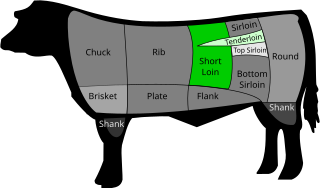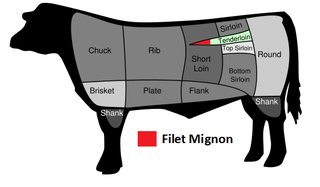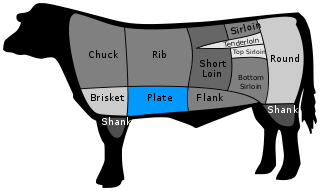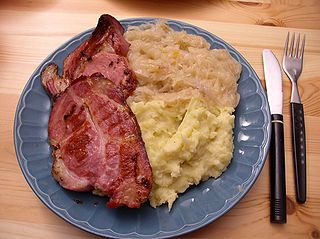
Scrag end is a cut of lamb and mutton taken from the neck and common in the United Kingdom and the Commonwealth. It is a primal cut separated from the carcass during butchering. [1] [2]

Scrag end is a cut of lamb and mutton taken from the neck and common in the United Kingdom and the Commonwealth. It is a primal cut separated from the carcass during butchering. [1] [2]
Scrag end is one of the cheaper cuts of meat, and is often used in soups and stews. [3] In the United State, scrag end is known as the neck. Unlike scrag end, cutlets come from the part of the neck considered best, known as the middle neck.

A beefsteak, often called just steak, is a flat cut of beef with parallel faces, usually cut perpendicular to the muscle fibers. In common restaurant service a single serving will have a raw mass ranging from 120 to 600 grams. Beef steaks are usually grilled, pan fried, or broiled. The more tender cuts from the loin and rib are cooked quickly, using dry heat, and served whole. Less tender cuts from the chuck or round are cooked with moist heat or are mechanically tenderized.

Lamb, hogget, and mutton, generically sheep meat, are the meat of domestic sheep, Ovis aries. A sheep in its first year is a lamb and its meat is also lamb. A sheep in its second year and its meat are hogget. Older sheep meat is mutton. Generally, "hogget" and "sheep meat" are not used by consumers outside New Zealand, South Africa and Australia with the exception of the Navajo people in the American Southwest, who consume mutton as a staple part of their diet. Historically, Navajo sheep ranching has been regulated by the Federal Government due to habitat destruction caused by sheep overgrazing.

The T-bone and porterhouse are steaks of beef cut from the short loin. Both steaks include a "T"-shaped lumbar vertebra with sections of abdominal internal oblique muscle on each side. Porterhouse steaks are cut from the rear end of the short loin and thus include more tenderloin steak, along with a large strip steak. T-bone steaks are cut closer to the front, and contain a smaller section of tenderloin. The smaller portion of a T-bone, when sold alone, is known as a filet mignon, especially if cut from the small forward end of the tenderloin.

A butcher is a person who may slaughter animals, dress their flesh, sell their meat, or participate within any combination of these three tasks. They may prepare standard cuts of meat and poultry for sale in retail or wholesale food establishments. A butcher may be employed by supermarkets, grocery stores, butcher shops and fish markets, slaughter houses, or may be self-employed.

A beef tenderloin, known as an eye fillet in Australasia, filet in France, Filet Mignon in Brazil, and fillet in the United Kingdom and South Africa, is cut from the loin of beef.

Filet mignon is a cut of meat taken from the smaller end of the tenderloin, or psoas major of an animal carcass. In French it can refer to the tenderloin of several animals but is mostly used to refer to cuts of pork tenderloin.
Trolls are fictional monsters in the Dungeons & Dragons roleplaying game.
The Global Rocket 1 (GR-1) was a Fractional Orbital Bombardment System (FOBS) intercontinental ballistic missile (ICBM) developed but not deployed by the Soviet Union during the Cold War. The system also was given the NATO reporting name SS-X-10 Scrag, and carried a Soviet GRAU index of 8K713.
Scrag can refer to:

Pork ribs are a cut of pork popular in Western and Asian cuisines. The ribcage of a domestic pig, meat and bones together, is cut into usable pieces, prepared by smoking, grilling, or baking – usually with a sauce, often barbecue – and then served.

A hanger steak, also known as butcher's steak or hanging tenderloin, is a cut of beef steak prized for its flavor. This cut is taken from the plate, which is the upper belly of the animal. In the past it was sometimes known as "butcher's steak", because butchers would often keep it for themselves rather than offer it for sale. This is because the general populace believed this to be a crude cut of meat, although it is actually one of the most tender.

The tri-tip is a triangular cut of beef from the bottom sirloin subprimal cut, consisting of the tensor fasciae latae muscle. Untrimmed, the tri-tip weighs around 5 pounds. In the U.S., the tri-tip is taken from NAMP cut 185C.

During butchering, beef is first divided into primal cuts, pieces of meat initially separated from the carcass. These are basic sections from which steaks and other subdivisions are cut. The term "primal cut" is quite different from "prime cut", used to characterize cuts considered to be of higher quality. Since the animal's legs and neck muscles do the most work, they are the toughest; the meat becomes more tender as distance from hoof and horn increases. Different countries and cuisines have different cuts and names, and sometimes use the same name for a different cut; e.g., the cut described as "brisket" in the US is from a significantly different part of the carcass than British "brisket". "Cut" often refers narrowly to skeletal muscle, but can also include other edible flesh, such as offal or bones without significant muscles attached.

Short ribs are a cut of beef taken from the brisket, chuck, plate, or rib areas of beef cattle. They consist of a short portion of the rib bone, which is overlain by meat which varies in thickness. There are two major types of cuts: The "flanken", which is cut across the bone and leaves the bone just 1 to 2 inches in length, and the "English", which is cut parallel to the bone and leaves the bone up to 6 inches (15 cm) in length. English cut short ribs may be served individually, or three or four may served connected to one another. Short ribs are popular in many international cuisines.

Pork loin is a cut of meat from a pig, created from the tissue along the dorsal side of the rib cage.

Tafelspitz is boiled veal or beef in broth, served with a mix of minced apples and horseradish. It is a classic dish of the Viennese cuisine and popular in all of Austria and the neighboring German state of Bavaria.

My Brother the Pig is a 1999 American fantasy-comedy film, directed by Erik Fleming and starring Scarlett Johansson, Judge Reinhold, Alex D. Linz, and Eva Mendes.

Kassler or Kasseler in German cuisine is the name given to a salted (cured) and slightly smoked cut of pork similar to British gammon. It can be either hot or cold smoked. Pork necks and loins are the most often used cuts although ribs, shoulders and bellies can also be used. It is often served with sauerkraut and mashed potatoes.

A catch dog is a specially trained dog that is used to catch large animals in hunting, working livestock, and baiting.

The Monitors is a 1969 U.S. satirical science fiction film. Shot in Chicago, it was the first film production of the city's Second City comedy troupe and was coproduced and financed by the Bell and Howell film-equipment manufacturing company in an effort to establish Chicago as a film production center. It is based on the 1966 novel of the same name by Keith Laumer.